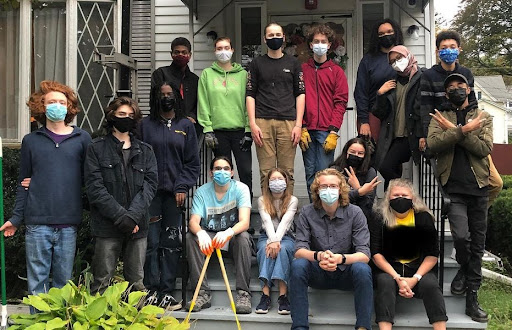by Robin Mitzcavitch, Director of Religious Exploration & Education

I look back to years ago when I first began volunteering with my own children at IHN Family Shelter. This was when IHN had a day center in the basement of a church. Each evening, right before dinner, the vans would be loaded with families who were homeless and they’d be dropped off at an area church or synagogue for a meal and an overnight stay. After breakfast, the vans returned to bring families back to the day center for showers, and then to work and school. Each participating partner would house families in their space for 1 to 2 weeks, and the families would rotate through approximately 30 houses of worship over the course of a year. Now, IHN has a static shelter residence which houses up to seven families. This is so much easier on the families than the successful but nomadic way the program was originally built.
One year, when my own children were young teens and we were volunteering at my former church, there were a lot of homeless teens in the shelter program with their families. My daughter and son would help make dinner, and then hang out after dinner, playing board games or ping pong in our church’s fellowship hall. My family was signed up to help for two nights. After the second night, we were driving home and my daughter asked, “How does a homeless teenager even have friends? I mean, they can’t invite people to the shelter, right?” She was right and it was a very disturbing realization for my two teens. They were sad. Later that evening, they came to me and asked if they could invite their own friends to hang out with them at the shelter…..so the teens living there would have a group of “friends” (at least for 2 weeks!). And they did just that, and showed up every evening after dinner to hang out with the teens in the shelter.
Many people think that shelter, food and clothing for a homeless teenager is enough. And it is a start. But, when a teen is in a shelter, it’s isolating and so much different than being an adult or a small child in the same circumstance. Think about how challenging it is to be a teenager anyway: growing up and changing, trying to maintain your own uniqueness, but also trying to fit in. Moving away from underneath your parents’ wings, but still in need of guidance and security. Wanting to be part of an extracurricular group, a sport, an outing…but having curfews at a shelter. Most shelters do not allow visitors. Most teens wouldn’t invite a friend “home” to the shelter even if they could. It’s a stigma. What happens when they’re assigned to a “group” science project or something of that nature at school. It could be a crisis for a homeless teen.
Last weekend, our Youth Group, who normally travels away on a “mission trip”, had to stay put because of COVID. They still spent their time in outreach. On Saturday, the Youth Group pooled money, went grocery shopping, and prepared a beautiful meal in our church kitchen for the IHN Family Shelter. On Sunday, they gathered the meal, pumpkins for the kids, and their work gloves. We met at the shelter on 91 June Street in Worcester. The group weeded, raked leaves, cut the grass, built beds for the guest rooms.They did pumpkin painting with the little ones, and served dinner. But it wasn’t until after dinner that the most important outreach began.
Our Youth Group hung out with the families. There were a number of teens in the Youth Group who had never been in a homeless shelter environment before. They didn’t know what to expect. Soon, I witnessed that perfect moment which unfolds when a realization blossoms on the face of an expectant young person. The realization is that this mother, this father, this child, and this teen is just a regular person. I don’t need to be worried, awkward, or scared. This teen is just like me, the same age, smart, funny, likes to play UNO and to dribble a basketball. These are “my people” who are living inside in a much different circumstance.
And like my own children did 15 years ago…our Youth Group teens were right there, filled with empathy. They asked the teens at the shelter to join them, play cards, climb on the monkey bars, and pass a football. For that one Sunday evening, they broke the isolation and were friends. They invited the highschool- aged teen to our Youth Group. They acted as role models for the middle school teens, showing their kindness and how cool it is to be a caring person.
Every time we end a Youth Group event, we circle up and link hands. Each person says a “one- word” check out, they perform a couple of “secret handshake moves”, and a final cheer. On Sunday, as we did this, our group turned to the teens who they had just met at the shelter and invited them into their circle. It was getting dark out, but I saw their eyes shining. All of their eyes. It felt good to be included. It felt good to be inclusive. This is outreach. This is love.
With Love,
Robin
